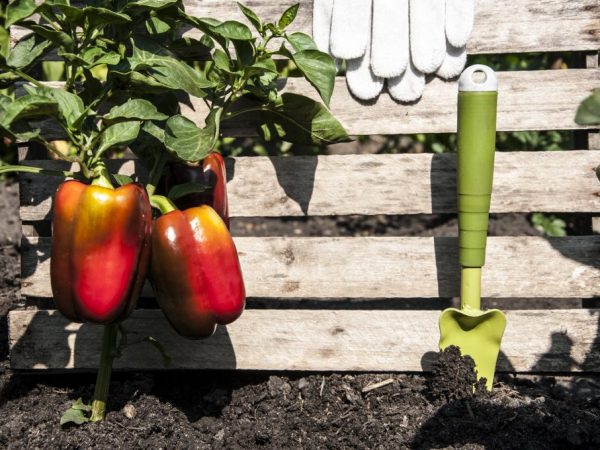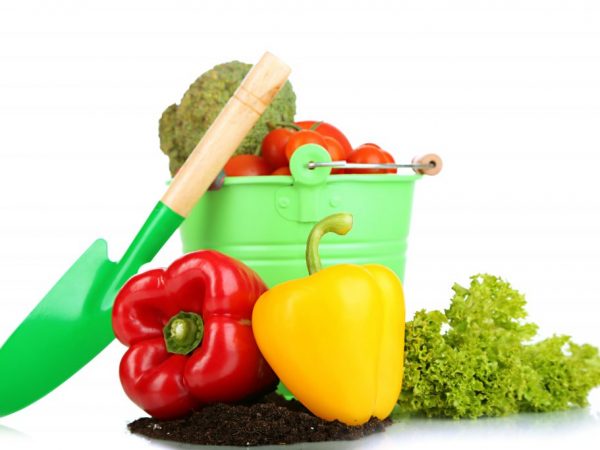Description of Pepper Red Shovel
Bell pepper Red shovel refers to crops that need proper planting and some care. Despite these factors, the sweet vegetable is especially popular among gardeners.

Description of Pepper Red Shovel
Variety characteristic
Pepper Red Spade was introduced in Russia in 1976. In the early 80s of the twentieth century, he was sent to conduct research and after 3 years it was entered in the State Register of the Russian Federation.
The variety is suitable for growing in all regions of the country. She has excellent yields both when grown in the open field and when grown in a greenhouse. About 6 kg of selected fruits are harvested from 1 bush.
Plant features
According to the characteristics, the fruits ripen early. The growing season from the moment the first shoots appear until the beginning of fruiting is only 110 days. The bush is compact, not spreading, its height is 60 cm.
The color of the leaves is rich green, the surface is rough, with sparse bumpy areas. The root system is developed horizontally.
Description of the fetus
According to the description of the variety, the shape of the fruit resembles an elongated cylinder. Small flattened areas are observed along the edges, resembling a shovel. This is what the name of this variety is based on. The length of an individual fruit is 15-18 cm. The ripened weight is 120-150 g. At the time of biological ripeness, the fruits acquire a rich red hue. Wall thickness - 7-8 mm.
The pulp is juicy. The taste is rich, sweet, with a pronounced peppery aroma.
Planting seeds
Training
First of all, seeds are disinfected to reduce the risk of disease. For these purposes, a weak manganese solution is used. Seeds are placed in it for half an hour, after which they are taken out and dried.
The next step is to test for germination. It is carried out as follows:
- put gauze cloth on a hard surface;
- seeds processed with potassium permanganate are placed on top;
- put another 1 layer of fabric on top;
- seeds wrapped in cloth are placed in a warm room for a week;
- a week later, the result is checked: the seeds on which sprouts have appeared are ideal for planting, and those on which there are no sprouts are thrown away, since they are not suitable for planting.
Then the seeds are hardened. For this, the selected seeds are placed in a refrigerator for 10 hours. This is necessary so that future seedlings can easily tolerate low ambient temperatures and are less sick.
Disembarkation

Good yields are only possible with proper planting.
To begin with, the soil is treated with a manganese solution. This removes bacteria and harmful microelements from the soil. The cultivated land is poured into the container, small grooves are made in it. Their depth should not exceed 1 cm. The seeds are placed at a distance of 2-3 cm from each other. After that, the seed grooves are covered with another layer of earth and covered with plastic wrap.The container is moved to a warm place for 7-8 days, until the first shoots begin to show.
A week later, the film is removed, otherwise the seedlings may die. An open container is placed on a windowsill, where the seedlings can receive the required amount of sunlight. In order for the root system and the plant itself to form correctly, the temperature regime is kept in the region of 20-28 ° C.
Picking
The next stage is picking. Its main task is to provide a larger area for the development of sprouts on seedlings. It is necessary to completely cut off all small shoots. Each plant is transferred to a separate container. All actions should be carried out with extreme care so as not to damage the roots.
Planting in soil
As soon as the Red Spade pepper seedlings reach 60-70 days of age, they are transplanted to a permanent place. A few days before planting, a hardening process is carried out. To do this, all containers with seedlings are taken out daily for 2-3 hours. The ambient temperature should not be lower than 16 ° C.
Planting in a greenhouse or open ground is possible only at a temperature of 18-20 ° C. It is carried out in cloudy and windy weather. A distance of 70 cm is kept between the rows. The distance between the bushes is 50-60 cm. It is best to plant no more than 3 bushes per 1 square meter. m.
Care requirements
Sweet pepper Red shovel demanding care.
First, irrigation should be carried out correctly and fertilizers should be applied in a timely manner. Watering is carried out every 3-4 days with a moderate amount of warm water, because warm water allows the root system to better take root in the soil. Drip irrigation is ideal as it reduces the risk of root rot. Top dressing is carried out three times during the entire growing season:
- The first subcortex is carried out with humus at the beginning of flowering.
- The second top dressing is nitrogen fertilizers at the time of fruit formation.
- The third - a few weeks before harvest. It is advisable at this moment to use phosphorus-potassium substances, which allow the fruit to better reveal all its taste.
The soil is loosened in a timely manner and weeds are removed. If there is no time for weeding, you can mulch the beds. To do this, mix equal amounts of straw and humus. Do not forget about the regular tying of the bushes, because the abundance of fruits leads to deformation of the bush.
Fighting insects and diseases
Despite the fact that the Red Spade pepper has a good immune system, due to improper care, a number of diseases and an invasion of parasites are possible. When the first signs of tobacco mosaic appear, the plant is sprayed with Araks or Confidor preparations. In the fight against powdery mildew, a weak solution of manganese or a 1% solution of Bordeaux liquid is used.
When parasites such as aphids or spider mites appear, they use traditional medicine. In the fight against aphids, copper-containing preparations come to the rescue, and spider mites are disposed of with a solution of wood ash or garlic.
Conclusion
The Red Spade variety is an excellent option for growing in the central and northern regions of the country. Due to its resistance to low temperatures and most diseases, this variety is ideal for beginners in the gardening industry.


